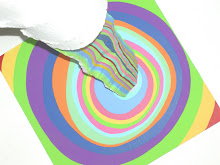This week I went to a lecture at Chester University given by the artist Leo Fitzmaurice. Well, I had never heard of him before. I have definately been missing out! Not only is his work the sort that I really enjoy looking at and experiencing (I would love to actually see some in a gallery situation), but work that relates to my ideas and interests so much that it makes me want to learn more and create more.
'Using found and altered objects to re-contextualise the banal and everyday, changing our ways of seeing the familiar by altering or coupling objects with others'.
Leo Fitzmaurice is a British artist who remixes existing objects and in particular, discarded advertising and consumer materials. His work starts with simple observations. He often begins with an object he is irritated by, reworks it, and begins to enjoy it in other ways. His chosen material comes in the form of everyday materials specific to Western culture - flyers, packaging, consumer detritus. What particularly interested me is the way in which Fitzmaurice imposes a strict system from the beginning, imposing strategies and tactics in the creation of a piece. With his flyer pieces for example, he simply layed the flyers on the ground in a formation until that particular flyer ran out. Then he would start on a different one until a patchwork was generated. With my work often the system used in creating the piece is more important than the final outcome itself. And certainly with Fitzmaurice's work the idea of a system used to generate the pattern seems an important one.
Another point I found interesting was Fitzmaurice's use of language, or rather lack of. In one piece he re-works found carrier bags, extending the design until it no longer resembles that of the supermarket we recognise it as. But the point is we still do recognise it. Whether this is because of the common universal language of packaging that we all associate with or because of colour and pattern connotations we continue to relate to. We can still see elements of the original products but they have been abstracted. He obscures the information and in effect removes the original function of an object, while at the same time keeping the essence of the material and allowing other elements to breed. For him it is not a case of obliterating information but finding a new dialogue with the material. In this way he doesn't impose himself too much, but just enough.
The main connection and interest I have with Fitzmaurice's work is simply the way in which he starts with a simple observation of the everyday. This interest in the mundane materials of everyday life has been with me for a number of years now. A simple thought of 'What would that object look like without writing on?' is all it takes to completely re-work something just by changing it slightly and simply. Seeing the potential in something so simple. That's what it is all about for me! With his box sculptures he takes everyday packaging, the simple box, and removes any trace of information displayed. These boxes when displayed together then create a kind of cityscape. This idea of an objects relation to others is an important one. One box alone would be a box with holes in, but this mass accumulation of boxes creates a real visual impact and a mere box becomes a skyscraper. The importance of a simple box is exaggerated. What I particularly like about this as well is that it is evident of the process that has been involved in creating this work. The time consuming and repetitive nature of cutting out all of the words from all of those boxes. This investment of time and effort heightens somethings importance in and of itself.
Something he said during the talk resonated with me greatly. He said that he had begun buying things now for the packaging rather than the contents inside. This is the collection taken to the extreme, as I well know. It is a thought that has occurred to me many times whilst looking at my own accumulations. I myself began to buy chocolates not for the chocolate inside but for the wrappers that covered them. This is happening increasingly so. Something Fitzmaurice does that I haven't the guts to do quite yet is to pick up 'stuff' in the street. He then alters it and often returns it to its original setting, changing an objects identity then replacing it.
I am so glad I attended this lecture as it has opened up a whole new set of agendas for me to be interested in. For example I hadn't really thought about how language could play a part in my work. This is something I could possibly look into. More than anything though I have been able to relate myself and my own interests to Fitzmaurice's work. The way he notices the un-noticed, how he documents everyday observations, the imposing of a strict system and materials so the work generates itself, and working within the limitations of an idea and how far you can push that. More than anything he prompts people to look and opens up a visual search of the things we see everyday, pushing connections between objects and everything around them. All of this is what I am deeply interested in at present and seeing Fitzmaurice's work has made me even more keen to continue developing in this vein of thought.
'Leo Fitzmaurice highlights the obscure forms beauty can take, articulating its constant presence and its reliance on the eye of the beholder'.

No comments:
Post a Comment